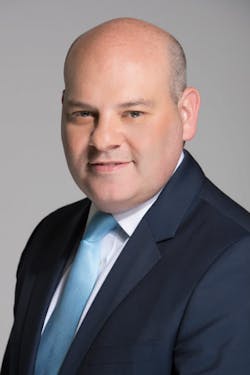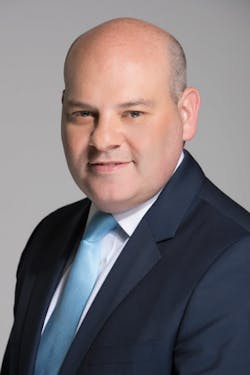Leading Fluence Corporation, the merged company between US firm RWL Water and Israeli newbie Emefcy, CEO Henry Charrabé believes there is future growth in the decentralised water and wastewater markets, particularly in China. Here he speaks to WWi about why this is a $15 billion market.
By Tom Freyberg
The worlds of cosmetic makeup and wastewater treatment couldn’t be further apart. One deals with the business of models, catwalks and glamour products. The other, human waste. Yet there is one company and investor providing a link between the two.
Billionaire Ronald Lauder is the youngest son of and heir to cosmetics giant Estée Lauder Companies and was the founder behind US firm RWL Water, which carried his initials. Today, he is the major shareholder owning 34 percent of Fluence Corporation - the recently launched company merging together RWL and Emefcy.
Henry Charrabé, who has taken the reins as CEO of Fluence, has worked for Lauder for the last 16 years.
“He will continue to be very much involved in an ambassadorial role and advise,” he says. “I’m here in New York not too far from his offices. He has access to global leaders, both on the political and business, industrial fields. He continues to make those introductions and when the talk of water and wastewater treatment comes up he will continue to advocate for the company and will have a major interest.”
Targeting the central void
It was in July when the two companies officially joined forces. The merge brought together the more experienced RWL Water, with 7000 installations across 70 countries with industry newcomer Emefcy, which had a handful of projects lined up across its home nation of Israel, as well as Ethiopia and China. Following the announcement, Fluence secured a further $11 million from an unnamed US-based investor. Already listed on the Australian Securities Exchange, the company said the investment helps it anticipate a listing on the US stock exchange as well.
Fluence aims to adopt the same mantra as RWL - targeting the middle market-sized projects in the range of $5 million to $50 million. It doesn’t want to compete with Veolia-scale businesses.
“Decentralised water and wastewater treatment systems allow you to really go where the customer requires you to go and not only focus on very large water and wastewater treatment plants,” says the CEO.
“If you need a wastewater treatment plant for the city of Chicago, then Fluence is not the best bet. But if you look into the wide variety on the planet where you have decentralised, fast to deploy and sometimes packaged mobile treatment plants then I think Fluence is one of the main leaders in this field.”
China ambitions
Part of Fluence’s mission statement is to target China’s rural wastewater market, which it estimates to be worth $15 billion over the next five years.
“The way we came up with the $15 billion is because the China Five-Year Plan requires that the rural wastewater treatment capacity goes from 10 percent to 70 percent, which is about 440 million inhabitants,” says Charrabé.
“Then you extrapolate from there, that 440 million - how much of that requires the MABR wastewater treatment module. You come up with the treatment capacity that you intend - a couple of thousand cubic metres per day, given that it’s rural wastewater, and that gets you to $15 billion.”
The appeal of the China market, he adds, is that the Five-Year Plan provides a time component for the company to work towards. To date, Fluence has signed with nine integrated partners - including state owned entities (SOEs) and also private integrators.
Moving the needle
One of the reasons for the merger between the older and new company is the access to Emefcy’s MABR technology. Charrabé says it allows for 50 percent lower operation costs than “traditional treatment systems”. As can be read on page 14, multiple companies are now involved in the MABR space, including GE and Irish start up Oxymem.
“It’s really hard to come up with really disruptive and proven water and wastewater technologies. MABR is just that,” says the CEO.
Over the last two and a half years Emefcy has collected data on the US Virgin Islands, where they received USEPA approval, as well as plants in Ethiopia and several demo and commercial plants now in China.
“It’s one of those technologies that has moved the needle because of the lower OPEX and higher efficiency that we can operate under the smaller ranges.”
Adding firepower
RWL Water initially built up its business through a series of acquisitions, including Israeli desalination business Nirosoft and Italian firm, Eurotec.
“I think we have quite some firepower now,” says Charrabé. “In the past RWL Water grew through acquisitions. This was during the first 18-24 months of its lifetime but then during the next four years we really grew organically. So I think the combination with Emefcy to create Fluence - it’s not an acquisition it’s a combination - is just adding what you call firepower going forward.”
Continued innovation
When a nimble start up is acquired by a larger global entity this can sometimes put the brakes on innovation. What were once nimble, small teams who could move quickly are soon bogged down by added layers of bureaucracy, not to mention global geographical and cultural differences.
This shouldn’t be the case with the Fluence merge. RWL Water was a small enough size that it allows for the innovation from Emefy to carry on, yet it has the financial backing and clout of Ronald Lauder and other shareholders to keep pushing the needle, as Charrabé says.
The global water market is in desperate need of game-changing technology success stories to prove that innovation can be scaled up and the market accepts it. Perhaps the Fluence and MABR journey could be just what the industry needs.
Tom Freyberg is the chief editor of WWi magazine.
More Water & WasteWater International Archives Issue Articles
About the Author

Tom Freyberg
Tom Freyberg is an experienced environmental journalist, having worked across a variety of business-to-business titles. Since joining Pennwell in 2010, he has been influential in developing international partnerships for the water brand and has overseen digital developments, including 360 degree video case studies. He has interviewed high level figures, including NYSE CEO’s and Environmental Ministers. A known figure in the global water industry, Tom has chaired and spoken at conferences around the world, from Helsinki, to London and Singapore. An English graduate from Exeter University, Tom completed his PMA journalism training in London.

